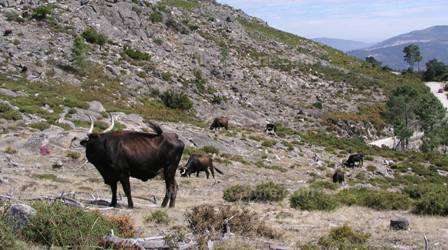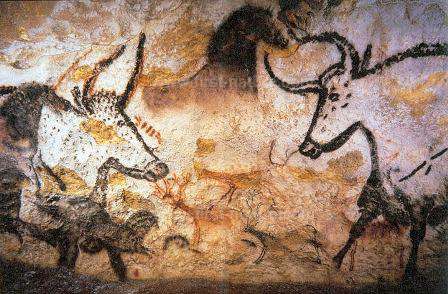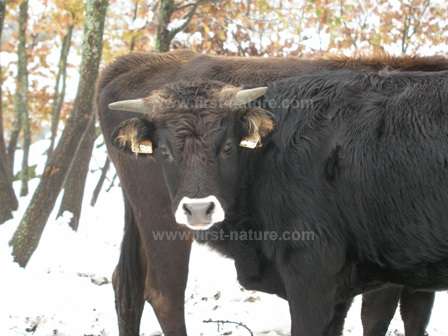At One with Nature – Raising the Auroch - Sue Parker has a beef with cattle farming
Based on an article by Sue Parker in Algarve Resident, March 28th 2014. Algarve Resident is the leading English-language newspaper and the source of essential information for Residents and would-be Residents in the Algarve.
For more information about Algarve Resident...
Other than expressing mild interest when they see cattle such as the Scottish Highland breed with their long horns and thick winter coats, most Europeans rarely give cows a second thought. They are merely sources of milk and meat. Not so in America, where tourists in their thousands flock to national parks to see Bison (Buffalo). To many Americans Bison, like the Grizzly Bears and Moose, are symbols of their heritage, ancient beasts that speak of a Wild West that was truly wild with a capital W. They also make magnificent burgers.

Cattle related to ancient breeds can graze marginal land of little use for growing crops
A Jersey cow will never invoke the excitement generated by the sight of male Bison charging each other on some vast American plain; nevertheless, it’s a fact that the Jersey cow also had a wild and woolly ancestor in its distant past. The Eurasian ancestor of farmed cattle - the Auroch - was first domesticated in Neolithic times and only became extinct in the sixteenth century. Like the Bison, which we frequently see photographed in deep snow at freezing temperatures, Aurochs were far hardier than the cosseted, antibiotic-laden creatures that satisfy our demands for milk and meat today.
The True Nature Foundation’s new Uruz Project aims to find and conserve ancient cattle breeds that are most closely related to the hardy Auroch and then to increase their populations. Portugal, which is still home to rare old breeds such as Maronesa, Barrosa and Raça Brava, is playing a leading role in this initiative.
Restoring these ancient breeds of cattle may not attract eco tourists to Portugal in the way that the emblematic Bison does in America, but there is no doubt that Aurochs had immense significance in our past. It is obvious from ancient cave paintings that the Auroch’s importance in the lives of our ancestors was as much cultural as culinary.
While funding the purchase of cattle for study and breeding purposes, the main thrust of the Uruz Project is to help local farmers to care for and breed more of these potentially valuable and profitable animals for the benefit of future generations.

Aurochs depicted in ancient cave paintings demonstrate their cultural as well as food value. Picture: courtesy Prof Saxx
While some still deny that Mankind’s activities are contributing to climate change, there is no doubt that our unsustainable lifestyles are depleting the planet of natural resources at an alarming rate. Modern food production has enormous environmental impact, and our taste for meat plays no small part in this environmental catastrophe.
Some 40 percent of the world’s grain production is used as fodder for cattle that ultimately feed relatively few people on the planet. Meanwhile, the staple diet of billions of people who cannot afford the luxury of meat is grain – the cereal crops rice, corn, wheat and barley. The starvation of millions of people around the world is only exacerbated by using grain to accelerate meat production for the favoured few. It is estimated that America’s grain production for cattle could, instead, feed more than 800 million people, raising the important questions: is feeding grain to cattle sustainable? Is cattle grazing the best use of prime agricultural land?
Hardy ancient cattle breeds are tough enough to be able to graze the kind of marginal land that is of little or no use for other forms of agriculture. That makes close relatives of the Auroch a much more sustainable proposition than modern-day high maintenance cattle. While over-grazing also harms the land and causes soil erosion, when properly managed the impact is much less than that of grain production.

A young Maronesa bull
Apart from soil erosion, the amount of water required for modern high-intensity cattle farming is as significant a problem for countries such as Portugal, where water is at a premium: growing grain for cattle consumes around 100 litres of water per kg of meat protein produced. In contrast, growing soya beans or rice consumes 2 litres of water per kg of protein, and potatoes even less. There’s no doubt the world could support a lot more people sustainably if we were wholly or mainly vegetarian. Despite this meat consumption is rising around the world, and increasingly scientists believe that it is our past that may hold the key to a sustainable future for meat production rather than the economics-led industrialised farming of today.
Abandoning meat eating altogether is not an acceptable answer for those of us who love nothing more than a juicy steak to accompany a delicious glass or two of Portuguese Red. But we could eat less of it – make meat a treat rather than part of our daily diet. Meat eaters unite! Let’s support this admirable project to produce sustainable beef for our descendants to enjoy.
More information on the Uruz Project: https://www.facebook.com/truenaturefoundation and www.truenaturefoundation.org

